On 26 October 2022, Keppel Pacific Oak US REIT (“KORE”) have announced their 2022 third quarter business updates. Overall despite the negative market outlook, KORE’s results have been relatively stable as at 30 September 2022, and they seem well position to ride out the uncertainty in 2023.
Nonetheless, KORE is the REIT that have the highest risk to reward ratio that I am covering in my blog, with its direct and concentrated exposure to the US office space. Currently it is trading at a significant discount from its book value, and there are good reasons for it to be at these levels. Indirectly it also provides a large buffer for the possibility of property valuation write-downs over the short-term, which is covered under the “Key things to note” section.
I have added more considerations for this article given the nature of its assets. If there is anything I missed out, feel free to let me know. Will be more than happy to look into it and include in my next article.
Background
KORE is a distinctive office REIT listed on the main board of the Singapore Exchange Securities Trading Limited (“SGX-ST”) on 9 November 2017.
KORE’s leverages its focus on the fast-growing technology, advertising, media and information (“TAMI”), as well as medical and healthcare sectors across key growth markets in the United States (“US”), and aims to be the first choice US office S-REIT providing sustainable distributions and strong total returns for Unitholders.
KORE invests in a diversified portfolio of income-producing commercial assets and real estate-related assets in key growth markets characterised by positive economic and office fundamentals that generally outpace the US national average and the average of gateway cities. These markets include the Super Sun Belt and 18-Hour Cities, which have and continue to see an accelerated influx of talent as part of The Great American Move.
As at 31 December, KORE’s portfolio comprised a balanced mix of 15 freehold office buildings and business campuses across nine key growth markets driven by technology and innovation in the US. With a combined asset value of USD1.46 billion and an aggregate net lettable area of approximately 5.1 million sf, these properties encompass a diversified high-quality tenant base in the growing and defensive sectors of TAMI, as well as medical and healthcare, which make up 45.2% of KORE’s portfolio by cash rental income.
KORE is managed by Keppel Pacific Oak US REIT Management Pte. Ltd., which is jointly owned by two Sponsors, Keppel Capital and KORE Pacific Advisors (“KPA”).
Key Metrics
Distribution Per Unit (“DPU”)

Based on the announcement on 26 October 2022, DPU was not included in the business update for the third quarter of 2022.
For 2022Q2 It is worth noting that in the presentation slides, management have provided an adjusted DPU comparison. The reason is because the Manager has elected to receive 100% of its base fee for 2022Q1 amounting to USD1,657,009 in the form of Units and 100% of its base fee for 2022Q2 amounting to USD1,664,343 in cash.
Accordingly, the 2021 comparatives adjusted income available for distribution to Unitholders, adjusted DPU and adjusted distribution yield have been restated to assume 2021Q2 base fee of USD1,500,161 were paid in cash to provide a like-for-like comparison to 2022Q2 actual results.
While there are merits of doing so, I will exclude this adjustment because the issuance of management fee in the form of units is also dilutive to the unitholders. It does not change the fact that an existing unit holder if they were to have held from 30 June 2021, they will see the DPU from their holdings decreased by 9.5% to USD0.0143 per share from USD0.0158 in 2021Q2.
As at 30 June 2022, this metric is Unfavorable.
Occupancy

Occupancy rate as at 30 September 2022 stands at 92.5%. This is Unfavorable as it is below my expected healthy occupancy rate of 95% and KORE have not been able to fully utilize their assets.
This is part of the high risk to reward ratio that I have mentioned earlier. Unlike Singapore, the US have embraced remote and hybrid work till date, with the larger companies having terminated their leases. Before the pandemic, 95% of offices were occupied, whereas today that number is closer to 47%.
Website: The ‘office apocalypse’ is upon us
This does not however make excuses for KORE’s 92.5% to be considered favorable. Overall it will still have DPU impact should the environment worsen further. KORE has a Weighted Average Lease Expiry (“WALE”) of 3.4 years which should provide sufficient income visibility. However, it is still possible for leases to be early terminated. For investors that are risk adverse, it may be worth considering other REITs with stable occupancies.
Gearing ratio

Gearing ratio stands at 37.5% as at 30 September 2022 . This to me is Favorable, as there is sufficient buffer from the MAS limit of 50%. This may play an important role for KORE as I am expecting some form of valuation write down of US properties in the short-term. The buffer may be utilized to prevent any force selling of assets and KORE can also take advantage to raise debt to fund acquisitions if opportunities arose.
Interest coverage

The interest coverage stands at 4.4 times as at 30 September 2022. The metric is Unfavorable as the interest coverage is lower than my preference of 5.0 times and seems to be worsening. This is a concern as interest rates continue to rise as the world looks to tackle inflation. The Federal Reserve on 14th December 2022 has hiked interest rates by another 0.5% to 4.5%, the highest level in 15 years, and is looking to to keep rates higher through next year with no reductions until 2024.
Website: Fed raises interest rates half a point to highest level in 15 years
As the interest rate may potentially increase further, KORE may be subjected to significant change in their cost of debt in the near future. In their presentation they have mentioned that 76.8% of their debt is also on fixed rates.
I have thus performed a sensitivity analysis using the information as at 30 September 2022:

Interest rate sensitivity analysis as below:

Do note the above is my estimation which may be different from management’s estimation. Nonetheless, if the interest rates were to increase by the basis points above, KORE may experience a fall in DPU accordingly.
Debt maturity profile

Weighted average term to maturity of their debt stands at 3.9 years as at 30 September 2022. This is Favorable and it allows them sufficient time to refinance their debts as they fall due.
Price to Book Ratio

Based on the announcement on 26 October 2022, net asset value (“NAV”) was not included in the business update for the third quarter of 2022.
Using 30 June 2022 figures, the Price to Book (“P/B”) ratio currently stands at 0.52. This is computed using the closing share price of USD0.435 on 23 December 2022 and the net asset value per share of USD0.830 as at 30 June 2022.
The metric is Favorable as we are paying below book value for its assets. This provides sufficient buffer should there be a significant write-down of valuation for its assets. However, there is a reason for it to be traded at this P/B ratio and is covered under the “Key things to note” section.
Dividend yield

With a closing share price of USD0.435 as at 23 December 2022 and expected dividend payout of USD0.056, this translates to a dividend yield of 12.78%.
Interest rates have been continuously increasing the last few months, this have prompted for multiple safer assets to increase their bond and interest rates to more than 3%. For my benchmark, a general reasonable range would be around an average of 6.0% to 7.0% in the current environment. KORE’s dividend yield is way above my benchmark.
Website: Reasonable Dividend Yield Changes
Despite paying a decent dividend, the dividend yield metric is Neutral due to the uncertainties in the market.
The current macro-environment suggest that the US office REITs may be facing significant downward pressure in the short-term which is covered under the “Key things to note” section. As part of the risk to reward ratio assessment, I evaluated a scenario where the valuations and dividend yield were to be halved to 6.69% in 2023.
In the event that dividend yield does get halved, based on the dividend of USD0.28 there is potential for KORE to see its share price drop by another 8% to USD0.400 to achieve a dividend yield of 7%.

Do note that the below is my illustration should a worst case scenario occur. Management have taken steps to ensure that it does not happen. If the dividend payout is able to be maintained, the dividend yield would be attractive for the long term.
Other metrics
Tenant profile
KORE has an enlarged portfolio covering multiple trade sectors. The high quality and diverse tenant base provides resilience to the KORE portfolio across challenging events, as evidenced during the ongoing COVID-19 pandemic. The top-10 tenants accounted for only 23.3% of KORE’s portfolio with no single tenant accounting for more than 3.5% during the period, providing income diversity to the portfolio. Furthermore the WALE of the top 10 tenants is 4.5 years, which provides a strong income visibility as the US rides out the uncertainty.
Key things to note
Risk of property valuation write-down
The US office space have been on a downturn the last few months with occupancy decreasing. As the world continues to increase interest rates to combat inflation, businesses are starting to feel the impact as enter 2023, with sources for cheap funding drying up. Technology companies are shrinking payrolls and downsizing their footprints, especially in gateway markets, adding to the hurdles already facing the office sector.
Website: Tech Pullback, Rising Interest Rates Further Complicate US Office Recovery
While we may not necessary see a Global Financial Crisis (“GFC”) level kind of crash, in general there are estimates that property prices could drop 20%-30% in 2023, before seeing an uneven recovery after that.
Should the property valuation decrease by 30%, this will have implications as the gearing ratio of KORE will increase to approximately 53.8% from the current 37.5%. This will breach the MAS limit and KORE will be forced to raise funding via equity or sale of properties to lower their gearing. Both options may not be desirable given that the share price is trading at a significant discount of its book value or KORE may have to realized losses if they are unable to dispose of their assets at book value.
Website: The party is over in commercial real estate. Here’s what to expect in 2023.
Whether KORE’s property valuation will take a write-down will only be known after 31 December 2022 with their audited financial statements. However, the share price have already started to decrease in anticipation of the magnitude of write-downs, decreasing by 45.63% over the past 1 year. This is coupled with the fact that this is a foreign investment REIT that is listed on SGX, where these kinds of REIT profile are less appealing to Singapore investors.

Management have actively mitigate this risk, as seen by the recent divestment of Powers Ferry in Atlanta, Georgia. The net divestment prices was 2.5% above its last independent valuation as at 31 December 2021, although it is USD0.2 million less than the book value after taking into consideration the divestment costs.
This is one way to help unlock value for unit holders. The P/B ratio of 0.52 would indicate a buffer that KORE can afford to sell its assets up to a 48% discount.
Summary

Overall, the metrics indicate that it is neutral to invest in KORE. The recent market conditions present opportunities for entry as the share price continues to face downward pressure and trade at a significant discount from its book value.
Despite the relatively stable results, investors need to take note that of their risk appetite as KORE may not necessary be worth the risk. Especially as safe assets have seen their yield rise considerably with rising interest rates, the appeal of KORE may take a turn for the worse and further downside may happen.
Disclaimer: Not financial advice. All data and information provided on this site is for informational purposes only.




